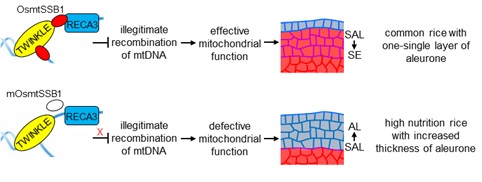Rice endosperm is a major source of human dietary calories. The rice endosperm comprises an outer single cell-layer aleurone and an inner starchy endosperm. Aleurone accumulates many nutritional factors such as lipids, proteins, B-type vitamins, antioxidants, dietary fibers and micronutrients, while starchy endosperm (the white rice) accumulates mainly starch. From the heath point of view, white rice is poor in nutrients. Thus, increase the thickness of aleurone is a potential strategy to enhance the nutritional value of rice.
Recently, an over ten-year collaboration from teams of the Institute of Botany, Chinese Academy of Sciences (IB-CAS), the Institute of Rice Research, Shandong Academy of Agricultural Sciences (IRR-SDAAS), and School of Advanced Agricultural Sciences, Peking University (SAAS-PKU) identified a thick aleurone 1 (ta1) mutant from rice that showed an increased number of aleurone cell layers and improved nutrition profiles.
Molecular genetic analyses showed that the TA1 gene encodes a mitochondria targeted single stranded DNA-binding protein OsSSB1. Mutations in TA1 led to a developmental switch of subaleurone cells towards aleurone, instead of towards starchy endosperm in normal rice, suggesting that OsmtSSB1-mediated mitochondrial function plays an important role in determination of the subaleurone cell fate.
Through years of crosses and backcrosses, the team developed a black rice variety Zhongzi-1 with an increased number of aleurone cell layer, which combined the high antioxidant feature of the black rice and high-nutrition feature of the ta1 mutation.
with an increased number of aleurone cell layer, which combined the high antioxidant feature of the black rice and high-nutrition feature of the ta1 mutation.
Thus, this study provides a new avenue for nutrition improvement in rice, and possibly for other cereal crops as well.
This study was published online recently in Molecular Plant.
The study was supported by the Chinese Academy of Sciences Innovation Project, the Beijing Municipal Science and Technology Commission Project, the CAS-CSIRO Bilateral Collaboration Project and the National Transgenic Science and Technology Program.

OsmtSSB1-mediated mitochondrial function determines the subaleurone cell fate, and subsequently the number of aleurone cell layers (Image by Dr. Chun-Ming Liu's group). AL: aleurone. SAL: subaleurone. SE: starchy endosperm.
Article Link:https://doi.org/10.1016/j.molp.2021.05.016
Contact
LIU Chun-Ming
Institute of Botany, Chinese Academy of Sciences
E-mail: cmliu@ibcas.ac.cn
Rice endosperm is a major source of human dietary calories. The rice endosperm comprises an outer single cell-layer aleurone and an inner starchy endosperm. Aleurone accumulates many nutritional factors such as lipids, proteins, B-type vitamins, antioxidants, dietary fibers and micronutrients, while starchy endosperm (the white rice) accumulates mainly starch. From the heath point of view, white rice is poor in nutrients. Thus, increase the thickness of aleurone is a potential strategy to enhance the nutritional value of rice.
Recently, an over ten-year collaboration from teams of the Institute of Botany, Chinese Academy of Sciences (IB-CAS), the Institute of Rice Research, Shandong Academy of Agricultural Sciences (IRR-SDAAS), and School of Advanced Agricultural Sciences, Peking University (SAAS-PKU) identified a thick aleurone 1 (ta1) mutant from rice that showed an increased number of aleurone cell layers and improved nutrition profiles.
Molecular genetic analyses showed that the TA1 gene encodes a mitochondria targeted single stranded DNA-binding protein OsSSB1. Mutations in TA1 led to a developmental switch of subaleurone cells towards aleurone, instead of towards starchy endosperm in normal rice, suggesting that OsmtSSB1-mediated mitochondrial function plays an important role in determination of the subaleurone cell fate.
Through years of crosses and backcrosses, the team developed a black rice variety Zhongzi-1![]() with an increased number of aleurone cell layer, which combined the high antioxidant feature of the black rice and high-nutrition feature of the ta1 mutation.
with an increased number of aleurone cell layer, which combined the high antioxidant feature of the black rice and high-nutrition feature of the ta1 mutation.
Thus, this study provides a new avenue for nutrition improvement in rice, and possibly for other cereal crops as well.
This study was published online recently in Molecular Plant.
The study was supported by the Chinese Academy of Sciences Innovation Project, the Beijing Municipal Science and Technology Commission Project, the CAS-CSIRO Bilateral Collaboration Project and the National Transgenic Science and Technology Program.

OsmtSSB1-mediated mitochondrial function determines the subaleurone cell fate, and subsequently the number of aleurone cell layers (Image by Dr. Chun-Ming Liu's group). AL: aleurone. SAL: subaleurone. SE: starchy endosperm.
Article Link:https://doi.org/10.1016/j.molp.2021.05.016
Contact
LIU Chun-Ming
Institute of Botany, Chinese Academy of Sciences
E-mail: cmliu@ibcas.ac.cn
